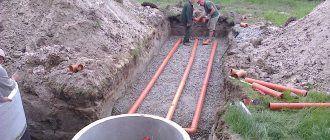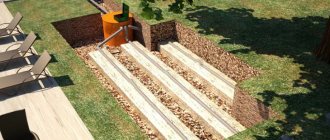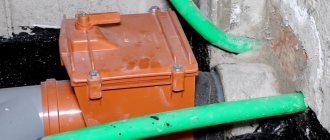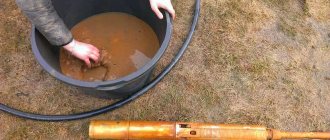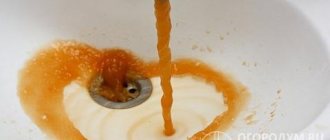Real estate
00:00, 19.04.2021 15
We consider the three most popular ways to drain water from a septic tank - a filter well, filtration fields and drainage tunnels
Photo: ibud.ua
Regardless of what septic tank is installed on your site, the clarified (purified in the septic tank) water will need to be disposed of somewhere. It should not be dumped into ponds or ditches unless you have an aeration plant that disinfects the drains. The solution is ground filtration as a method of water purification. There are three popular ground filtration systems among our homeowners, and we propose to talk about them today.
How to determine the filtration coefficient and why it is needed
First of all, the choice of system and the very possibility of soil-based water purification will depend on what kind of soil is on your site and what its filtration coefficient is. As we have already said, sandy soils and sandy loams have good water permeability, and on such soil it is easiest to arrange soil tertiary treatment of wastewater. At the other end of the scale are dense and waterproof clay soils, where this is very, very difficult to do. Loams are in the middle of the scale. On light and medium loams it is possible to make a ground filtration system, but on heavy loams this is no longer possible.
You can determine how quickly water filters through your soil using a simple “old-fashioned” method. Where you plan to install a filtration system, dig a hole (its depth should be lower than you plan to place the base of your structure). And start filling the hole with water, measuring time after time how long it will take for it to completely sink into the ground. After several iterations, calculate the average speed.
Now, knowing the wetted surface area of this pit (in square meters), the volume (in cubic meters), calculate the approximate filtration coefficient. To do this, divide the volume by the area and multiply by the time (in days). And in accordance with this coefficient, determine the permissible load on your filter system - use table 1 from STO NOSTROY 2.17.176-2015.
Of course, with all these calculations, you will need to take into account the load on the sewer system - clearly calculate how much wastewater you plan to produce per day and what the peak loads may be.
Photo: homesantehnica.ru
So which is better
These are only the most famous septic tanks. In reality, there are many times more of them, and only you can determine which septic tank is best for your home and garden. They all work more or less the same way, produce relatively clean wastewater at the output, but, in any case, require additional treatment of the wastewater.
When choosing, in addition to reliability (wall thickness and casting quality), a design, also focus on the cost of delivery and the complexity of installation. It is not always the case that delivery from a nearby city will be cheaper. Especially in the capital region, the opposite is often the case - for some reason it is cheaper to deliver from a nearby regional center.
Please read the design carefully before purchasing. In addition to the principle of operation, pay attention to the fact that the installation is convenient to maintain. There should be a wide neck, easy access to the inlet/outlet pipe and ventilation outlet. They have to be cleaned periodically, so this is important.
Request a call from a professional consultant. We will answer all questions, select equipment, and help you save!
All equipment can be purchased in 0% installments without overpayment.
The manufacturer may cancel the warranty for equipment if it is not purchased from an authorized representative.
Eurolos BIO and Topas are popular aeration septic tanks for country houses, private houses, and cottages. They have a durable sealed design, and the quality of cleaning is such that water can be discharged to open ground.
Septic tanks Eurobion and Topas produce deep biological wastewater treatment. After installing an autonomous sewer system, you can forever forget about the street toilet, the smell in the area, and calls for a sewer.
Eurobion is a full-fledged aeration station in which the wastewater is saturated with oxygen and purified by aerobic microorganisms. Compared to similar stations, it has a larger salvo discharge, a lower probability of blockages, and a simple electrical circuit with one compressor. But there are also disadvantages - the lack...
Poplar - aeration septic tank for private homes. It produces deep biological treatment of household wastewater with water discharge to the ground. Cleaning quality – up to 98%. After Poplar, you don’t have to do any additional soil purification (filtration field). Purified water has no odor and is harmless to the soil. Septic tank suitable for
How to move out of town if there is no sewerage in a private house? Use an outdoor toilet? It’s inconvenient, there are flies in the summer, it’s cold in the winter, the smell is unbearable, you have to constantly call the vacuum cleaner. Buy a dry toilet? It requires frequent cleaning, this must be done manually - not a pleasant task
Filter well - it couldn’t be simpler
Compact and simply designed filter wells are the simplest structure and, in this regard, the most popular among private homeowners. They are made from concrete rings or plastic. Holes with a diameter of 4-6 cm are evenly punched in the walls, and there should be a lot of holes: the total area is at least 10% of the entire wall area.
The depth of such a well must be at least 2.5 meters, and under it it is necessary to pour a base of crushed stone - 20-30 centimeters.
Actually, that’s all, the well is ready. Just don’t forget to make a filter at the bottom - a backfill of gravel and crushed stone. The height of such a filter should also be about three tens of centimeters. What coarse fraction this filter bed will have depends on what kind of soil you are working on. The largest filter can be installed on sand - 20-40 mm. In sandy loams the fraction should be smaller: 5-20 mm. And finally, on loams, choose the smallest caliber of the filtration pad - 3-10 mm.
Attention: make sure that the crushed stone is not limestone or dolomite, because it will quickly turn into crumbs and will not perform its functions.
Passing through this entire structure, water will be freed from residual mechanical impurities. The outside of the well must also be covered with gravel and/or crushed stone - right up to the pipe that goes into the septic tank. Then cover the top with geotextile and fill it with soil. There should be a hatch with a strong lid on top.
Photo: oksept.ru
That's it, your filter well is ready. It would seem that everything is simple, but there are limitations. Such structures are contraindicated if:
- you have dense soil (starting from medium loam),
- if the groundwater is high (there should be at least a meter left from the bottom of the well),
- and if the volume of waste from your home is more than 1 cubic meter.
Practice
Reading the forums of summer residents, you will notice: some people are not afraid to use such water for irrigation. True, watering is spot-on. That is, trees and bushes are watered with such water right at the root. Nobody irrigates lawns and lawns.
As for the smell, eyewitnesses say: there is no acrid suffocating smell from watering with such water. And the one that is available disappears within a few minutes.
The second half of gardeners are strongly against this approach. They explain their position by saying that it is dangerous. Such water may contain various bacteria and larvae. And if we add here household chemicals, which, one way or another, end up in the septic tank, then this is generally a guard.
We cannot agree with the first point. If only because almost everyone fertilizes their crops with manure. And no one is worried that some kind of “living creatures” might live there.
We can partially agree with the second point. Firstly, today there are phosphate-free detergents and cleaning products. By definition, they do not harm the environment. And secondly, conscientious summer residents know: a large amount of chemicals in a septic tank can kill all the bacteria that “work” there. So they use a minimal amount of it.
The filtration field is a disaster. Yes, not just one, but many.
If you have a good level of soil filtration, but more than 1 cubic meter of wastewater is generated per day, then filtration fields are shown to you. This path is also recommended for those who have little drainage, but groundwater lies close to the surface of the earth, which means it is impossible to make a filtration well.
So, the filtration field is a system of drainage pipes that are laid in the ground about half a meter from the surface with a slight slope. To do this, you can use ordinary plastic sewer pipes with a diameter of at least 100 mm. Cuts 5-10 mm wide are made in the pipes. Everything is connected together by a single pipe to the septic tank, and the water coming out of it is sent through the pipes, filtering into the ground through sawn slots. You will determine the number of pipes and the order in which they are laid depending on how much wastewater your farm plans to produce and how well the soil on the site filters water.
Of course, the pipes are not placed directly into the ground, but on a gravel and crushed stone base - it will have to be placed about two tens of centimeters high. But that’s not all - the pipe system must be filled with the same gravel and crushed stone, so that they cover the pipes by at least 10 centimeters. That's it, put a geotextile membrane on top, add soil - and you're done.
A contraindication to the construction of filtration fields is dense clay soil with a low water absorption coefficient. Otherwise, you risk getting a neat swamp on your site.
Photo: ufakolodec.ru
Draining from a septic tank with high groundwater level
When the water level is high, drainage from a septic tank should be done either into a filter cassette or forcibly pumped to a drainage filter.
A filter cassette is the same drainage ditch, only raised above ground level. In this case, instead of a third well, an embankment is made, inside which a crushed stone filter is installed. Water from the second container enters the cassette through forced pumping.
Or they make a large-capacity drainage filter with an outlet after it into the gutter. The filter is installed below the groundwater level, and the water stands in it, gradually overflowing into the drain. Water from the second container enters the filter, pumped by a pump.
To allow drainage from the septic tank into a filter cassette or drainage filter in winter, each of these structures is insulated (penoplex is best suited for this).
Drainage tunnel - a favorite new product
Ready-made drainage tunnels made of plastic (polyethylene or polypropylene) are a solution that appeared on the market not so long ago, but have already become popular with the owners of their own plots. This is a container without a bottom, often with perforated walls. If the walls are solid, a perforated drainage pipe is installed inside the container.
Such a tunnel holds a lot of water at once, so they are more efficient than filtration fields from pipes. Therefore, this solution to the problem of ground filtration is recommended for those who will have a large volume of sewage. And they will take up less space on the site.
You will assemble the tunnel itself from several modules that are connected to each other by pipes. They are laid in exactly the same way as filtration fields: gravel and crushed stone on top, gravel and crushed stone on the bottom, and a tunnel in the middle. But containers with solid walls on the sides and top are filled with sand and fine particles.
If groundwater rises high, a drainage tunnel can be built in an embankment, sprinkled with sand and soil about half a meter thick. A mound approximately 120 cm high will form on the site, and it will have to be decorated with something - because in appearance it most closely resembles a burial mound. But if you approach the matter creatively, everything will be fine.
How to preserve a septic tank for the winter
If you do not live in dachas or country houses in winter for more than one month, it is necessary to preserve the autonomous sewage system. Events are held before the onset of cold weather. A common mistake is completely draining liquids from the chambers. An empty station can become deformed or simply be pushed to the surface when the soil freezes or rises in groundwater or flood waters.
When purchasing factory-made cleaning units, follow the attached instructions, which describe in detail how to preserve the station. In general, conservation includes the following operations:
- removal of waste sludge; to simplify the process, special types of bacteria are introduced into the chambers 2 weeks before the start of cleaning;
- lowering the liquid level in the chambers to 2/3 of their volume with pumping out sludge or, if necessary, topping up to the specified value;
- power cut
- dismantling the compressor and pump
- To avoid damage to the walls of the container, given the theoretical possibility of ice crusts forming on the surface of the drain during unusually severe frosts, unique floats are placed in the chambers. These are 2-liter plastic bottles with sand and long ropes tied to the necks. Sand is poured in quantities that ensure that the bottles are immersed in the liquid by about two-thirds, and their upper part should be above the surface of the water. The sand holds the bottle upright. The plastic compresses under ice pressure, thereby reducing the pressure on the walls. After lowering the floats into the chambers, the ropes are secured in such a way that in the spring the bottles can be easily pulled out;
- close the structure with a lid;
- additional insulation of the structure using any heat insulators;
- in the northern regions, it is recommended to preserve the septic tank with additional insulation from the outside using any thermal insulation materials. You can lay a layer of fallen leaves, sawdust, moss, pine needles, dry grass or straw. From above, everything is covered with a thick plastic film and pressed down with earth. For the normal functioning of aerobic bacteria, an air flow is needed, so holes must be left in the insulating layer and film.
In home-made structures, there are no complex devices for managing and monitoring the work process, so conservation is carried out more simply, following a similar procedure. The listed measures make it possible to maintain the temperature in the treatment structure ≥ 4 degrees.
Septic tanks "Topas" with volley discharge 760 l for home
Septic tank TOPAS 10 Long Pr
| More details | Users: up to 8-10 people Salvo discharge: 760 l. Processing volume: 2 m3/day Price: 245,070 rub. |
Septic tank TOPAS-S 10 long Pr Us
| More details | Users: up to 10 people Salvo discharge: 760 l. Processing volume: 2 m3/day Price: 242,910 rub. |
